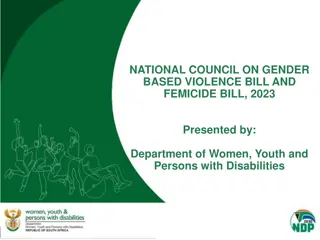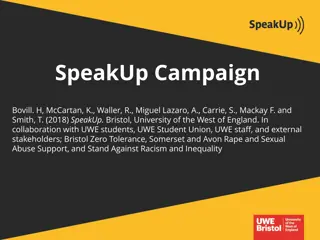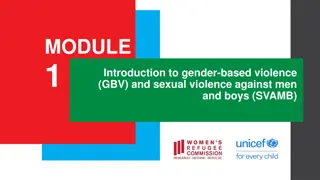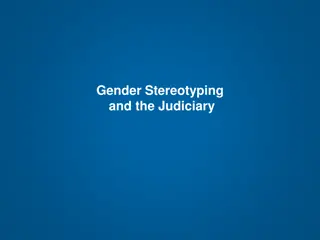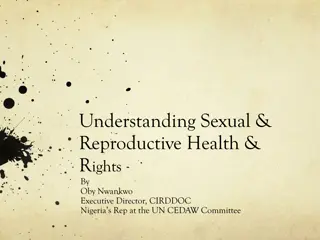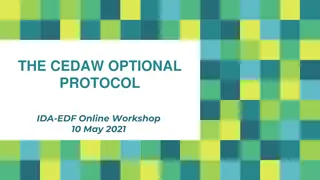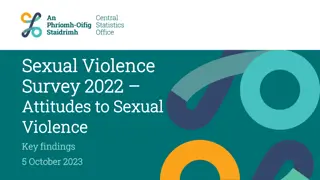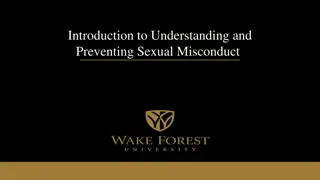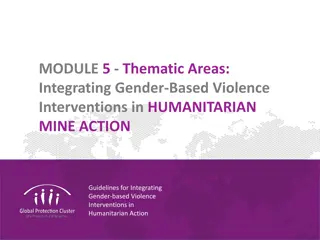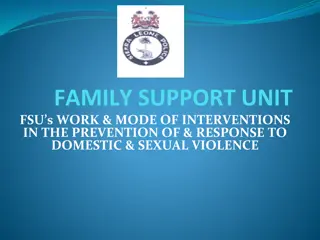Understanding Sexual and Gender-Based Violence: A Presentation by Oby Nwankwo at the UN CEDAW Committee
Presentation by Oby Nwankwo at the UN CEDAW Committee on Understanding Sexual and Gender-Based Violence, covering definitions, forms of violence, consequences on women & girls' health, taking action, the VAPP Act, and the role of traditional rulers in curbing SGBV.
Download Presentation

Please find below an Image/Link to download the presentation.
The content on the website is provided AS IS for your information and personal use only. It may not be sold, licensed, or shared on other websites without obtaining consent from the author. Download presentation by click this link. If you encounter any issues during the download, it is possible that the publisher has removed the file from their server.
E N D
Presentation Transcript
Understanding Sexual & Gender-Based Violence By Oby Nwankwo Nigeria Rep at the UN CEDAW Committee
Summary of Presentation Pre test Definitions of SGBV Forms of Violence Consequences on Health of Women & Girls Taking Action Understanding the VAPP Act Role of Traditional Rulers in curbing SGBV
Gender Gender is the socially constructed and differentiated roles & responsibilities assigned to men & women in a given culture or location. Roles & expectations vary across cultures, & societies. This construct & differentiation between men & women accord men a better status & greater leverage over resources than women. Women s poverty is directly related to the absence of economic opportunities, resources, including credit, land ownership & inheritance & minimal participation in the decision making process. Gender roles limit both women & men, but they generally have a more repressive impact on women& have restricted their participation in the development process. Despite progress made in increasing enrollment rates of girls in schools, gender inequality persists due to cultural factors, household responsibilities, early marriage & pregnancy. Gender roles have lifelong health consequences for women, starting in infancy.
Definitions Any results in, or is likely to result in, sexual, or psychological harm or suffering women, threats of coercion, deprivations whether occurring public or private life. act of GBV that GBV) is the general term used to capture violence that occurs as a result of the normative expectations associated with each gender, along with the unequal power relationships the two genders, within the context of a specific society. physical, role for including such or arbitrary of liberty, acts, between in -United Nations General Assembly 1993 (Bloom 2008, p14).
Gender equality is a principle of human rights and a sustainable development goal that requires a redistribution of power between women and men in terms of economic resources, legal rights, political participation and personal relations. The achievement of gender justice requires combining both gender equality and equity principles as a basis for social action. Effort to do this must deconstruct the notions of masculinity that promote aggressive sexual behaviours and domination of women.
Definition GBV shall mean violence that is directed against a woman because she is a woman or that women disproportionately [.] against women affects (Art. 3 d, Council of Europe Convention on preventing and combating violence against women and domestic violence) VAW is understood
Definitions While women, girls, men & boys can be victims of GBV, the main focus of this training is on VAW/Girls. GBV against men does exist. Men can also become victims of violence in the family by partners or children. (Bloom 2008, p14) It has been widely acknowledged that the majority of persons affected by GBV are women and girls, as a result of unequal distribution of power in society between women and men.
POWER 1 Power is the ability to influence your own or others experiences. It is important for us to be aware of how we use the power we possess. The power we exert over others is a negative use of power. When men use power to control women it is a negative use of power, and the driving force behind VAW. We must seek to transform negative uses of power into positive uses of power, which promote equality and solidarity.
Power 2 There are many varieties of positive power such as: the fundamental power we discover within when we learn to accept and love ourselves, the power we share with others when we support and respect each other, and the power we use to take action and positively influence our lives and the lives of others.
Power 3 While negative power is at the root of VAW, positive power holds the solution. The clearest path to VAW prevention is built upon balancing the power between women and men. Some people are afraid that balancing power means men will lose power and women gain power. Power is not in limited quantity; if one person gains power, it doesn t have to be at another person s loss. We all have power within ourselves, we can join our power with others and we have power to create positive change. Positive use of power by women and men means we all become stronger, safer, and more respected within our relationships.
Definition Examples: Physical: slapping, kicking, burning, strangulating Sexual: coerced sex through force, threats, etc. Psychological: isolation, verbal aggression, humiliation, stalking Economic: with-holding funds, controlling victim s access to health care, employment, etc. --Adapted from WHO TEACH-VIP, 2005
Sexual Violence The act of forcing (or attempting to force) another individual through violence, threats, verbal insistence, deception, cultural expectations or economic circumstances to engage in sexual behaviour against her/his will.. . it includes a wide range of behaviours from violent forcible rape to more contested areas that require young women to marry and sexually service men not of their choosing. --Heise, Moore and Toubia, 1995
As summarised by UNFPA They also suffer ( ) consequences [on their SRH], including forced and unwanted pregnancies, unsafe abortions and resulting deaths, traumatic fistula, and higher risks of sexually transmitted infections (STIs) and HIV. The primary targets of GBV are women and adolescent girls, but not only are they at high risk of GBV, they also suffer exacerbated consequences as compared with what men endure. As a result of gender discrimination and their lower socio-economic status, women have fewer options and less resources at their disposal to avoid or escape abusive situations and to seek justice. (UNFPA Strategy and Framework for Action to Addressing GBV, 2008-2011, p. 7
GBV Under International Human Rights Law - DEVAW VAW is a manifestation of unequal power relationships between men and women and a violation of women s human rights (preamble). Right to life, Right to equality, Right to the highest standard attainable of physical and mental health, or Right not to be subjected to torture, or other inhuman or degrading treatment or punishment.
Why SGBV/Attitudes Gender norms and inequity condone and perpetuate VAW. Gender influences the patterns of violence among men vs. VAW. VAW is used to support unequal gender roles. Notion that men have the right to control wives behavior and to discipline them Notion that there are just causes for violence. Blaming the victim for the violence received. Source: WHO TEACH-VIP, 2005
GROUP WORK Group 1 1. What does GBV mean to you? 2. Who is affected by GBV in your community? 3. What role do traditional leaders play in GBV? Group 2 4. Why does it happen? 5. How are victims of GBV dealt with in your community? 6. What role do traditional leaders play in GBV? Group 3 7. How are perpetrators dealt with? 8. What role do traditional leaders play in GBV? 9. What solutions would you propose for GBV in your community?
Forms of Violence
SGBV takes many different forms across all stages of the life cycle of girls & women Stage of life cycle Forms of SGBV (e.g. prenatal sex selection) Pre-birth (e.g. female infanticide, neglect) Infancy (e.g. FGM, child abuse, denial of opportunities) Childhood (e.g. forced prostitution, rape, trafficking, early marriage, sexual exploitation) Adolescence (e.g. sexual assault, trafficking, intimate partner violence, homicide/ femicide, sexual harassment, lack of freedom of movement and control of finances) Reproductive Age Elderly (e.g. widow abuse, elder abuse)
Domestic Violence Domestic violence is not an isolated, individual event, but rather a pattern of perpetrator behaviors used against a survivor. The pattern consists of a variety of abusive acts, occurring in multiple episodes over the course of the relationship. Some episodes consist of a sustained attack with one tactic repeated many times (e.g., punching), combined with a variety of other tactics (such as name calling, threats, or attacks against property). Other episodes consist of a single act (e.g., a slap, a certain look ).
Domestic Violence Contd. One tactic (e.g., physical assault) may be used infrequently, while other types of abuse (such as name calling or intimidating gestures) may be used daily. All parts of the pattern interact with each other and can have profound physical and emotional effects on survivors. Some parts of the pattern are crimes in Nigeria (e.g., physical assault, sexual assault, menacing, arson, kidnapping, harassment) while other battering acts are not illegal (e.g., name calling, interrogating children, denying the survivor access to the family automobile). Survivors respond to the entire pattern of perpetrators abuse rather than simply to one episode or one tactic.
Physical Violence may include the following and may or may not cause injuries. Spitting, scratching, biting, grabbing, shaking, shoving, pushing, restraining, Throwing, Twisting, slapping, punching, choking, burning, and/or use of weapons (e.g., household objects, knives, guns) against the survivor.
Sexual violence Sexual violence can take many forms and take place under very different circumstances. A person can be sexually violated by one individual or several people (e.g. gang- rapes); The incident may be planned or a surprise attack. Although sexual violence occurs most commonly in the survivor's home (or in the perpetrator s home), it also takes place in many other settings, such as the workplace, at school, in prisons, cars, the streets or open spaces (e.g. parks, farmland).
Sexual Violence Perpetrator of a sexual assault may be a date, an acquaintance, a friend, a family member, an intimate partner or former intimate partner, or a complete stranger, No stereotypical perpetrator; sexually violent men come from all backgrounds. Perpetrators may be persons in positions of authority - respected and trusted & less likely to be suspected. More often than not, is someone known to the survivor. Rape & sexual torture are frequently used as weapons to demoralize the enemy; Sexual violence is common in situations of war and armed conflict. women are sometimes forced into temporary marriages with enemy soldiers Women who are incarcerated may be subjected to sexual violence by prison guards and police officers.
Other forms of Sexual Violence forced exposure to pornography forced pregnancy forced sterilization forced abortion forced marriage female genital mutilation virginity tests Incest Sexual slavery sexual harassment (including demands for sex in exchange for job promotion or advancement or higher school marks or grades) trafficking for the purpose of sexual exploitation (WHO Guidelines for Medico-legal care of victims of Sexual Violence)
There are different types of psychological assaults. Threats of violence and harm Threats may be made directly with words such as I m going to kill you, Your mother is going to pay, Perpetrator s threats of violence or harm may be directed against the survivor or others important to the survivor or they may be suicide threats. or With actions such as stalking, displaying weapons, hostage taking, suicide attempts. Sometimes the threat includes killing the victim and others and then committing suicide.
Psychological violence Emotional violence Emotional abuse is a tactic of control that consists of a wide variety of verbal attacks and humiliations, including repeated verbal attacks against the survivor s worth as an individual or role as a parent, family member, friend, co-worker, or community member. In domestic violence, verbal attacks and other tactics of control are intertwined with the threat of harm in order to maintain the perpetrator s dominance through fear. While repeated verbal abuse is damaging to partners and relationships over time, it alone does not establish the same climate of fear as verbal abuse combined with the use or threat of physical harm.
Psychological violence Emotional violence Presence of emotionally abusive acts may indicate undisclosed use of physical force or it may indicate possible future domestic violence. Emotional abuse may also include humiliating the victim in front of family, friends or strangers. Perpetrators may repeatedly claim that survivors are crazy, incompetent, and unable to do anything right. Not all verbal insults between partners are acts of violence.
Psychological Violence - Economic Violence Perpetrators try survivors activities & contact with others. They gain over them through a combination isolating tactics. Isolating may become more overtly abusive over time. often control time, to control of tactics
Isolation While many survivors are able to maintain their independent thoughts & actions, others believe what the perpetrators say because the survivors are isolated from contrary information. Through his survivor s isolation, the perpetrator prevents discovery of the abuse and avoids being held responsible for it.
Psychological violence - Use of children Some abusive acts are directed against or involve children in order to control or punish the adult victim (e.g., physical attacks against a child, sexual use of children, forcing children to watch the abuse of the survivor, engaging children in the abuse of the survivor). Children are also drawn into the assaults and are sometimes injured simply because they are present (e.g., the victim is holding an infant when pushed against the wall) or because the child attempts to intervene in the fight.
Use of children A perpetrator may use children to maintain control over his partner by threatening to take children away from her, involving her in long legal fights over custody, or not paying child support, requiring that one child always be in the company of the survivor in order to spy, kidnapping or taking the children hostage as a way to force the survivor s compliance.
Economic Violence Conversely, he may refuse to work and insist that she support the family. He may expect her to be the family bookkeeper, requiring that she keep all records & write all checks, or he may keep financial information away from her. Perpetrators control survivors by controlling their access to family resources: time, car, food, clothing, shelter & money. It does not matter who the primary provider is or if both partners contribute. He may actively resist the survivor becoming financially self-sufficient as a way to maintain power and control.
Economic violence In all instances he alone makes the decisions. When the survivor leaves the battering relationship, the perpetrator may use economics as a way to maintain control or force her to return: refusing to pay bills, instituting legal procedures costly to the survivor, destroying assets in which she has a share. Survivors are put in the position of having to get permission to spend money on basic family needs.
Group Work Group 1 List examples of physical Gender Based Violence Group 2 List examples of Sexual Gender Based Violence Group 3 List examples of psychological Gender Based Violence
Consequences of SGBV on Women
Consequences Victims of SGBV suffer specific consequences. They emotional, HIV/AIDS, death, child abuse, trauma, low self-esteem, economic etc.). can be or general physical, economic sexual, (e.g. health, ill decline VAW families, societies the opportunity to reach their full potential. denies women, their and communities
Group Work Split into four groups Group 1: List the physical consequences of SGBV Group 2: List the Reproductive health consequences of SGBV Group 3: List the emotional consequences of SGBV Group 4: List the economic consequences of SGBV
GBV is a Public Health Issue Fatal Outcomes Femicide Suicide AIDS-related mortality Maternal mortality Non-fatal Outcomes Physical Sexual & Psychological & Behavioral Depression and anxiety Eating and sleep disorders Drug and alcohol abuse Poor self-esteem Post-traumatic stress disorder Self harm Reproductive Sexually-transmitted infections, including HIV Unwanted pregnancy Pregnancy complications traumatic gynecologic fistula Unsafe abortion Fractures Chronic pain syndromes Permane nt disability
Types of Violence Reproductive, Behavioural and Social Health Effects Childhood Sexual Abuse (For adolescent and adult victims) Gynecological problems, STDs, HIV/AIDS, early sexual experiences, early pregnancy, infertility, unprotected sex, unwanted pregnancy, abortion, re- victimisation, high-risk behaviours, substance abuse, suicide, death. Rape Unwanted pregnancy, abortion, pelvic inflammatory disease, infertility, STDs including HIV/AIDS, suicide, death Domestic Violence Poor nutrition, exacerbation of chronic illness, substance abuse, brain trauma, organ damage, partial or permanent disability, chronic pain, unprotected sex, pelvic inflammatory disease, gynaecological problems, low-birth weight, miscarriage, adverse pregnancy outcomes, maternal death, suicide, death
Consequences Violence during Pregnancy Violence and HIV/AIDS Forced sex is correlated to HIV risk Intimate partner violence prevalence during pregnancy Victims of violence tend to engage in behaviors that put their health at risk Leading cause of death among pregnant women may be homicide Proposing condom use may increase women s risk of violence Disclosing HIV status may increase risk of violence
Taking Action against SGBV
Taking Action Social services & NGOs can increase women s empowerment so that they can break free from the cycle of violence. Effective coordination among law enforcement, traditional institutions, legal aid services, health care organizations, educational institutions, and agencies devoted to social services and economic development. Traditional institutions sector can help change the norms & attitudes that perpetuate the idea that SGBV is okay. Legislation to protect victims rights. Health sector must ensure the integral health and rehabilitation of women.
Understanding the Violence against the Persons (VAPP) Act The VAPP Act prohibits violent acts such as: Inflicting physical injury on a person, 3-5 yrs, N100,000 N200,000 fine Willfully placing a person in fear of injury 1- 2 yrs, N100,000 N200,000 fine Depriving a person of his/her liberty 1- 2yrs , N100,000 N500,000 fine Abandonment of spouse or children 1-3yrs N100,000 N500,000 Attack with harmful substance 25 yrs life, no option of fine
VAPP Act Life imprisonment for rape which has been redefined to include penetration of the anus or mouth, not only of the vagina. Compensation for the victim is also provided Wilfully placing someone in fear of physical injury is an offence 2yrs Forceful ejection of spouse from home 1 2yrs or N200,000 - N300,000 Forced financial dependence or economic abuse 6 months - 2yrs or N100,000- 500,000 Forced isolation 3- 6 mths or N100,000 Emotional or psychological abuse 1 yr or 200k
VAPP Act 2015 Prohibits FGM 2- 4 yrs, N100,000 N200,000 fine Harmful widowhood practices 6 months - 2 yrs or 500,000 Spousal battery 1- 3 yrs or N100,000 200,000 Harmful Traditional Practices 2 4yrs or N100,000 - 500,000 Indecent exposure - 1 yr or 500k Incest - 10 yrs Violence by state actors 4 yrs or N1m Political violence 4 yrs or 500k Administering substance 10 yrs.
Thank you for your attention


